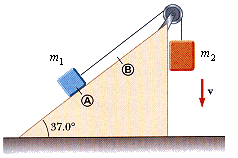- Joined
- Mar 31, 2005
- Messages
- 604
- Reaction score
- 0
A m1 = 49.0 kg block and a m2 = 100.0 kg block are connected by a string as in Figure P7.28. The pulley is frictionless and of negligible mass. The coefficient of kinetic friction between the 49.0 kg block and incline is 0.250. Determine the change in the kinetic energy of the 49.0 kg block as it moves from A to B, a distance of 20.0 m.

I made it into a tension/force problem at first, with the vertical or heavier block being the cause of the tension since the sum of the vertical forces of the tension was 0. So T = mg. So I knew what T was
Then for the block on the incline, I made a free body diagram where mgsin37 and Fk (friction force) pointed towards the left and T (tension) pointed towards the right. For vertical forces on the block, the sum was 0. So I can assume that n=mgcos37.
So my sigma Fx for the block on the incline was
T - mgsin37 + Fk
I calculated it and then plugged it into the work equation.
W= FDcos(theta)
Because the change of kinetic energy is just net work done. I thought W was my final answer.
Can anyone help me? Thanks!

I made it into a tension/force problem at first, with the vertical or heavier block being the cause of the tension since the sum of the vertical forces of the tension was 0. So T = mg. So I knew what T was
Then for the block on the incline, I made a free body diagram where mgsin37 and Fk (friction force) pointed towards the left and T (tension) pointed towards the right. For vertical forces on the block, the sum was 0. So I can assume that n=mgcos37.
So my sigma Fx for the block on the incline was
T - mgsin37 + Fk
I calculated it and then plugged it into the work equation.
W= FDcos(theta)
Because the change of kinetic energy is just net work done. I thought W was my final answer.
Can anyone help me? Thanks!
